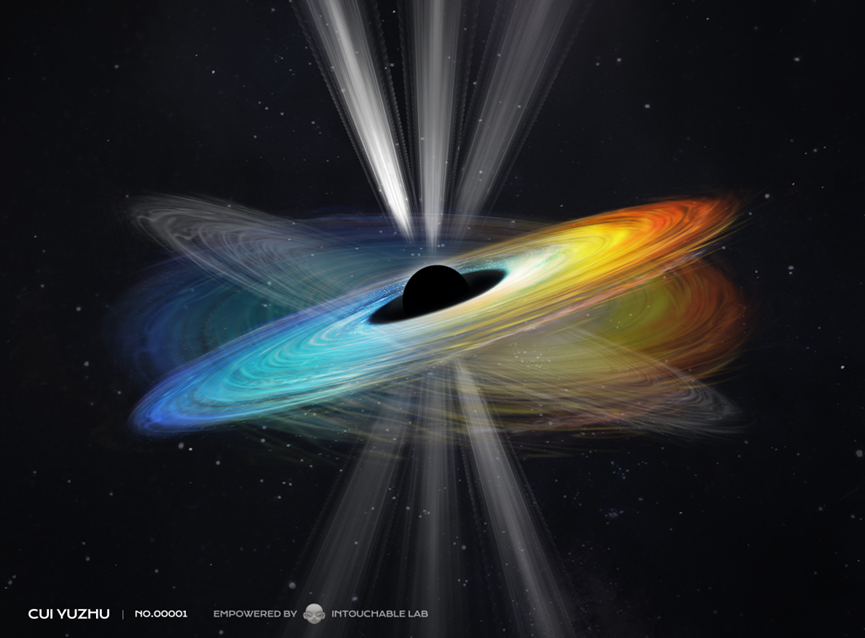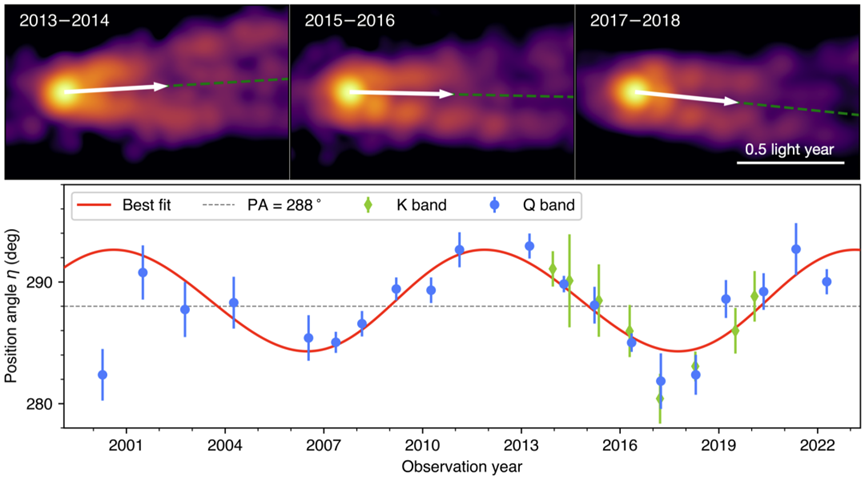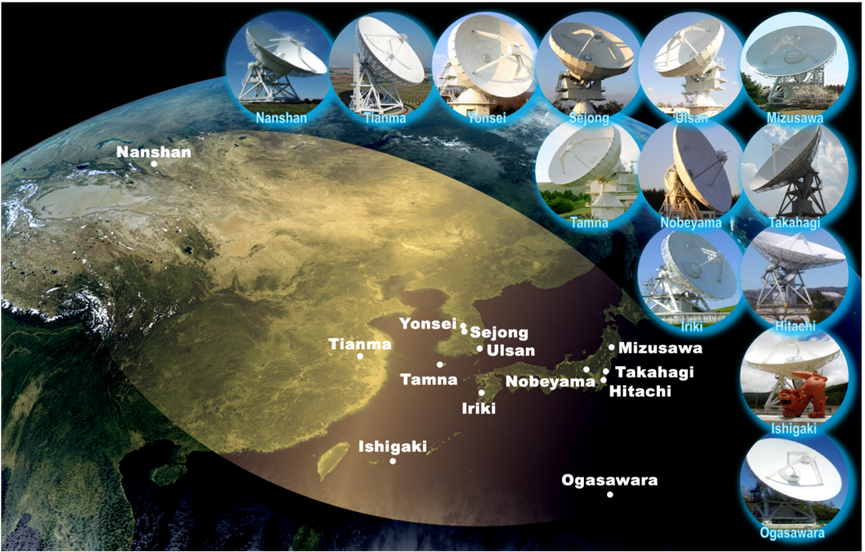

On September 27, 2023, Nature released the latest research findings of an international research team composed of 45 institutions. By analyzing the observation data from 2000 to 2022, it is found that the black hole jet at the center of the M87 galaxy exhibits periodic oscillations with a period of about 11 years and an amplitude of about 10 degrees. This phenomenon is in line with Albert Einstein's General Theory of Relativity, which predicts that "if a black hole is spinning, it will produce a frame-dragging effect. This study provides irrefutable evidence of the spin of the M87 black hole (Fig. 1). CUI Yuzhu, a postdoc from Zhejiang Lab (ZJ Lab), is the first author and corresponding author of the paper.

Fig. 1. Schematic Representation of the Tilted Accretion Disk Model. The black hole's spin axis is assumed to be straight up in this illustration. The jet direction stands almost perpendicular to the disk plane. The black hole's spin axis is misaligned from the disk's rotation axis, resulting in a tilted accretion disk. The misalignment between black hole and disk angular momenta triggers the precession of the disk and jet. (Source: Yuzhu Cui et al. 2023, Intouchable Lab@Openverse and ZJ Lab)
Successful Capture of Periodic Jet Precession
On April 10, 2019, astronomers from multiple locations around the world simultaneously unveiled the first image of a black hole, which is at the center of M87, a galaxy 55 million light-years away from the Earth, and 6.5 billion times more massive than the Sun. Such supermassive black holes are one of the most mysterious and destructive objects in the universe. They have a huge gravitational pull, "swallowing" large amounts of matter through accretion disks, while "spitting" matter thousands of light-years away at close to the speed of light. As a result, jets are formed.
"A curious straight ray emanating from the center of a hazy patch of light." This jet was first observed by an astronomer in 1918 in M87, which was also the first cosmic jet ever seen by human. What is the energy transfer mechanism among supermassive black holes and their accretion disks and jets? This question has puzzled physicists and astronomers for over a century.
At present, scientists widely believe that energy can be extracted from the angular momentum of a black hole. One possibility is that if there is a magnetic field near the black hole and the black hole is spinning, it will generate an electric field like a conductor cutting magnetic field lines, thereby accelerating the charged particles around the black hole, and eventually some of the matter will be ejected with huge energy. The spin of supermassive black holes is a crucial factor in this hypothesis. However, this spin is extremely difficult to measure, and there has been no direct observational evidence of a black hole spinning.
In order to tackle this challenging question, researchers studied the supermassive black hole at the center of M87 and its jets. Astronomers resolved jet structures close to the black hole with the Very Long Baseline Interferometry (VLBI) that provides ultra-high angular resolution. By analyzing VLBI observations from 2000 to 2022, researchers successfully captured the periodic precession of the jet in M87 (Fig. 2) (Precession: the phenomenon in which the axis of a spinning rigid object rotates about a center of mass when subjected to an external torque).
What force can alter the direction of such a powerful jet regularly? After extensive analysis, the research team concluded that the answer may be hidden in the dynamic properties of the accretion disk. An accretion disk forms when a matter with a certain amount of angular momentum orbits a black hole. The matter in that disk moves closer and closer to the black hole due to the gravitational pull until it is fatefully drawn into the black hole. However, the angular momentum of the accretion disk may be affected by a variety of random factors, and it would most likely be misaligned with the spin axis of the black hole. But the super-strong gravitational pull of a black hole will exert a significant impact on the surrounding spacetime, causing nearby objects to be dragged along its axis of rotation, namely "frame-dragging" predicted by Einstein's General Theory of Relativity, which in turn triggers the periodic precession of accretion disks and jets.

Fig. 2. M87 Jet Structure at 43 GHz Based on Bi-yearly Stacking Data Observed from 2013 to 2018. The corresponding years are indicated at the upper left corner. The white arrows indicate the jet position angle in each subplot. Below: The best fit results based on the yearly stacked image from 2000 to 2022. The green and blue dots are obtained from observations at 22 GHz and 43 GHz, respectively. The red line represents the best fit result according to the precession model. (Source: Yuzhu Cui et al. 2023)
The research team conducted a lot of detailed theoretical investigations and analyses based on observations, and used supercomputers to perform state-of-the-art numerical simulations combined with M87's properties. The results confirm that when the rotation axis of the accretion disk misaligns with the spin axis of the black hole, the entire accretion disk will precess due to the frame-dragging effect. As a result, the precessing disk will induce jet precession. Detecting this precession provides unequivocal evidence that the black hole at the center of M87 is indeed spinning, thus enhancing our understanding of the nature of supermassive black holes.
Revealing More about Black Holes Requires Computational Assistance
"We are happy and fortunate to have made this momentous discovery. In 2017, when I was working with M87 data observed with the East Asian VLBI Network (EAVN), I saw that the jet structure was significantly different in direction from previous structures. Since then, six years of detailed data processing, extensive theoretical research, and numerous discussions with collaborators have begun." CUI Yuzhu, the first author and corresponding author of the paper and a postdoc from ZJ Lab, said that since the misalignment between the black hole spin axis and the disk angular momentum is relatively small and the precession period is more than ten years, accumulating high-resolution data for over two complete cycles spanning 23 years and conducting a thorough analysis of M87's structure are essential to obtain this achievement.
"We are very grateful to our partners for their help and support, and to Nature's editors and reviewers for their valuable suggestions. It is worth mentioning that one of the reviewers of our paper is James Moran, a legend in the field of VLBI radio astronomy research," CUI Yuzhu said.
It is reported that this work made use of 170 epochs of observations obtained by several international observation networks, including the East Asia VLBI Network (EAVN), the Very Long Baseline Array (VLBA), the Korean VLBI Network (KVN) and Japan's VERA array (KaVA), and the East Asia to Italy/Russia Nearly Global (EATING) network. In total, more than 20 radio telescopes across the globe contributed to this study.

Fig. 3. Geographical Distribution of Participating Telescopes of EAVN (Source: Kazuhiro Hada, Yuzhu Cui et al. 2023)
Dr. Motoki Kino at Kogakuin University, the coordinator of EAVN Active Galactic Nuclei Science Working Group, said: "This is an exciting scientific milestone that was finally revealed through years of joint observations by the international researchers from 45 institutions around the world, working together as one. Our observations are perfectly fit to the precession model's predictions, which boosts our understanding of black hole and jet system significantly."
"This work also predicts that there will be more central black holes holding similar tilted accretion disks, which suffers more challenges to discover them. The remaining puzzles require sustained dedication to more long-term observations and detailed analyses." SHEN Zhiqiang, a research fellow at the Shanghai Astronomical Observatory of the Chinese Academy of Sciences which is our partner playing an important role in this achievement, said, "The Shanghai Astronomical Observatory's 40-meter-aperture radio telescope in Shigatse, which started construction recently, will further improve the high-resolution imaging capability of EAVN at millimeters, which is expected to spawn more astronomical discoveries."
CUI Yuzhu said that the accretion disk's structure and the exact value of the M87 supermassive black hole's spin are still highly uncertain. This further research depends on the searching of a very large number of physical parameters, which requires super intelligent computational power.
At present, ZJ Lab's open intelligent computing astronomical platform FAST@ZJLAB has integrated 17 intelligent algorithms, built scientific databases such as BlinkVerse (blinkverse.alkaidos.cn) and ChemiVerse in the fields of fast radio burst (FRB) and astrochemistry, and established a stable transmission channel with FAST, enabling the continuous aggregation of astronomical big data.
LI Di, Chief Scientist of FAST and Chief Scientist of Computational Astronomy at ZJ Lab, said that the completion of more radio telescopes will result in an explosion of observational data, making astronomical research increasingly dependent on intelligent computing. ZJ Lab is introducing AI, cloud computing and other technologies into astronomical research to improve data processing efficiency and expand the exploration space of physical parameters. We believe that the deep integration of computing science and radio astronomy could be a big boost to revealing the nature of black holes and other mysteries of the universe.
The paper's link: https://www.nature.com/articles/s41586-023-06479-6











